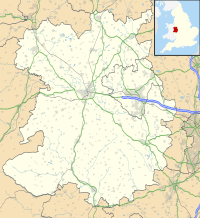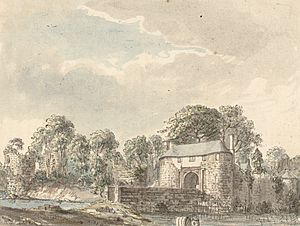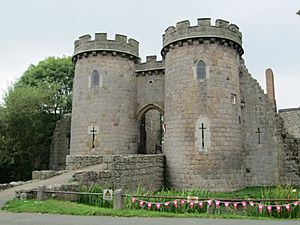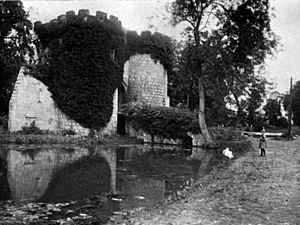Whittington Castle facts for kids
Quick facts for kids Whittington Castle |
|
|---|---|
| Shropshire, England | |
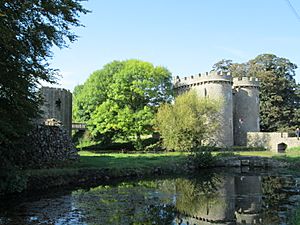
Whittington Castle in 2014
|
|
| Coordinates | 52°52′23″N 3°00′15″W / 52.8731°N 3.0043°W |
| Type | Castle |
| Site information | |
| Condition | Ruined |
Whittington Castle is a historic castle in northern Shropshire, England. It is looked after by the Whittington Castle Preservation Fund. The castle started as a simple "motte-and-bailey" castle. This means it had a wooden tower on a raised earth mound (the motte) and a fenced yard (the bailey). Later, in the 1200s, it was rebuilt with stone buildings around a central courtyard. The outer wall of this courtyard was a strong "curtain wall." Because it was built near the border of Wales and England, it was an important castle in the Welsh Marches. It is very close to the old fort of Old Oswestry.
Whittington Castle sits on a 12-acre property in the village of Whittington. This village is in the county of Shropshire in England. The castle is right next to Castle Road.
In 2003, experts studied the castle's history and archaeology. They found that the castle's outer area had two fancy gardens in the 1300s. These gardens were even surrounded by water! This discovery was very important. It showed that English gardens were quite advanced back then, even more so than some in France or Belgium. A member of the FitzWarin family created these beautiful gardens. The small hill in the middle of the garden might be the oldest viewing mound ever found in England.
Contents
History of Whittington Castle
Whittington is on the English side of Offa's Dyke. This was an old border between England and Wales. The castle might have started as a Norman manor house, but we don't have proof.
Early Castle Days
The site became a castle in 1138. It was built for William Peverel to support Empress Matilda. She was the daughter of King Henry I. Matilda was fighting against King Stephen for the throne during a time called The Anarchy.
In 1149, the area of Whittington became part of the Kingdom of Powys. This was a Welsh kingdom led by Madog ap Maredudd. It stayed Welsh until Madog died in 1160.
In 1165, King Henry II gave the castle to Roger de Powys. King Henry even gave him money to fix it in 1173. Roger's son Meurig, and then his grandson Werennoc, took over the castle.
The FitzWarin Family
A man named Fulk III FitzWarin also claimed the castle. He said it belonged to his family from the Peverels. King John did not agree at first, which led Fulk to rebel in 1204. But Fulk was forgiven, and he received the castle and the land of Whittington.
The castle then stayed in the FitzWarin family for many years. All the main owners were named Fulk.
Battles and Rebuilding
In 1223, Llywelyn ab Iorwerth of Gwynedd captured and destroyed the castle. But it was given back to England in a peace treaty. After this, the castle was rebuilt using stone.
The old wooden tower on a mound was replaced. Now, there was a strong inner bailey with buildings along a stone curtain wall. There were also five towers on a raised area surrounded by a moat. Beyond the moat was an outer gatehouse or "barbican."
For the next 40 years, the castle stayed with the English. But in 1267, it was given to Llywelyn ap Gruffudd. It remained under Welsh control until 1276.
Later Years and Decline
After Llywelyn ap Gruffydd was defeated in 1282, Whittington Castle became a grand home for the FitzWarin family. However, after Fulk VII died in 1349, the castle was often left empty. Its owners were usually too young or lived somewhere else. Some repairs were done around 1402.
In 1404, during the rebellion of Owain Glyndŵr, the land around the castle was ruined. But the castle itself was not captured.
In 1420, the FitzWarin family line ended. The castle went to Fulk XI's sister, Elizabeth. She married Richard Hankeford. In 1422, the castle was briefly captured by William Fitzwaryn and Richard Laken. But it was soon returned to Lord Clinton.
Later, the castle passed to the Bourchier family. In 1545, John Bourchier, 2nd Earl of Bath traded the castle with King Henry VIII. He got other lands that used to belong to monasteries.
A detailed report was made about the castle at that time. It said some of the buildings were "in decay." The castle was probably never lived in again after this. It changed hands many times. Eventually, it came to the Lloyd family, who still own it today.
In 1632, the castle gatehouse was rented out. The tenant was allowed to take stone from the castle. By the time of the English Civil War, Whittington Castle was not strong enough to defend itself. It did not play any part in that war.
Around 1760, one of the castle towers fell into the moat. Parts of the castle were even used to build roads. This included a new "turnpike road" to Ellesmere in 1776.
Castle Restoration
The castle is located on the old Holyhead Road. This meant many travelers noticed it. William Lloyd started repairing the gatehouse around 1808. He rented it out as a farmhouse. People lived there until the 1990s.
Today, Whittington Castle is managed by the Whittington Castle Preservation Trust. This group leased the castle for 99 years starting in 2002. The trust recently finished a big renovation project that cost £1.5 million.
Every year, the Historia Normannis group comes to the castle. They act out historical battles that would have happened in the area long ago.
Castle Legends
One famous legend about Whittington Castle is about the Marian Chalice. Some people believe this chalice is the Holy Grail. The story says that Sir Fulk FitzWarin, a guardian of the Grail, kept it in a private chapel at the castle. The family's coat of arms is still above the castle archway.
It is also said that the castle was part of the lands of a Welsh nobleman named Tudur Trefor. However, this part of the story seems to have been made up later.
- Fitz Warin Romance is an old story about the FitzWarin family.
Media Appearances
Whittington Castle was featured on an episode of the TV show Most Haunted on July 7, 2016.
See also
 In Spanish: Castillo de Whittington para niños
In Spanish: Castillo de Whittington para niños


